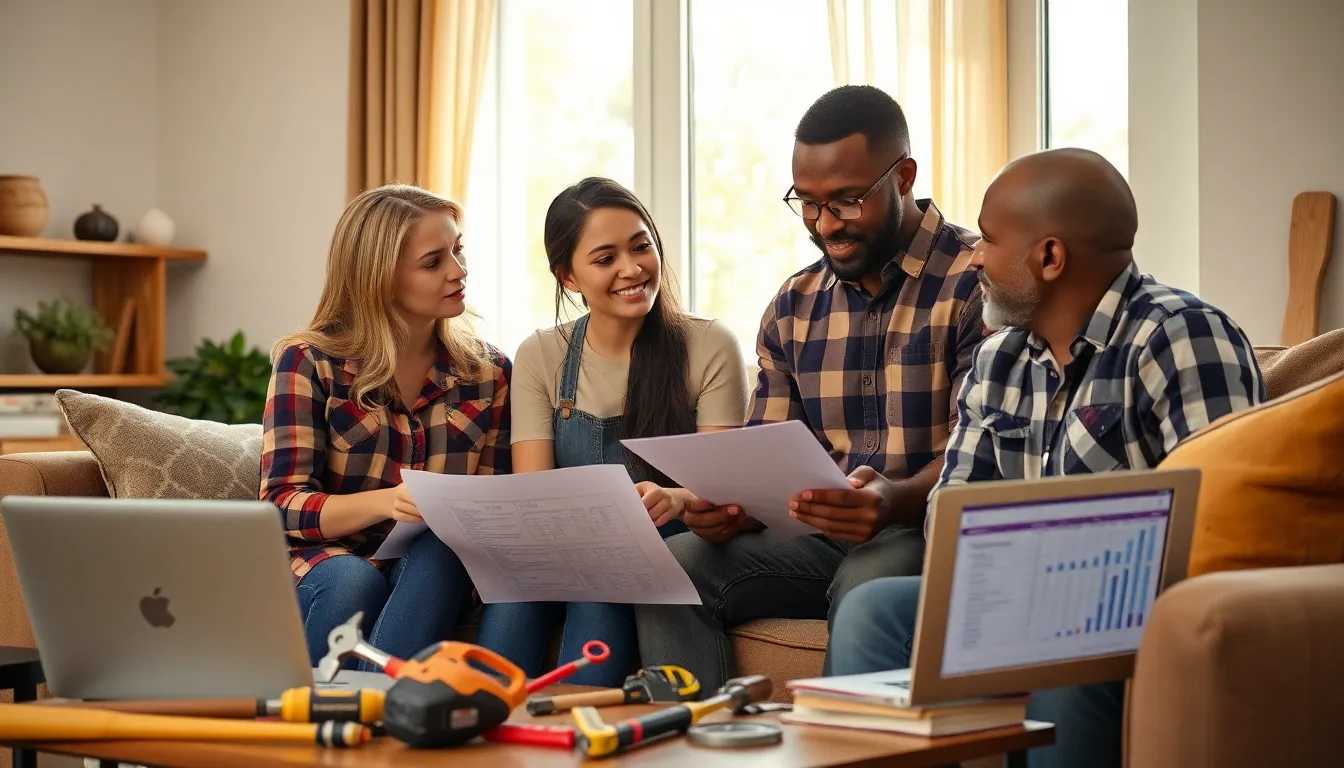Table of Contents
ToggleHomeownership often feels like a never-ending game of whack-a-mole. Just when you think you’ve tackled that leaky faucet, the roof decides it’s time to throw a tantrum. To keep your castle in tip-top shape, budgeting for home maintenance isn’t just smart—it’s essential. But how much should one really set aside? Spoiler alert: it’s more than the price of a fancy coffee!
Understanding Home Maintenance Costs
Home maintenance expenses can be significant and often go overlooked. Effective budgeting for these costs ensures homeowners maintain their properties wisely.
Importance of Budgeting for Home Maintenance
Budgeting for home maintenance prevents unexpected financial strain. Consistent setting aside of funds helps manage repairs and upkeep without panic. Homeowners face challenges regularly, and having a financial cushion makes addressing issues easier. It promotes proactive measures rather than reactive fixes. Saving approximately 1% to 2% of a home’s value annually is a common guideline used by experts.
Factors Influencing Maintenance Costs
Several factors determine the cost of home maintenance. The age of the home significantly impacts repair needs, with older properties typically requiring more work. Climate variations also play a role; homes in regions with extreme weather face different challenges than those in milder areas. Additionally, the type of materials used affects longevity and maintenance frequency. Regular inspections can help identify potential issues early, ultimately leading to cost savings on larger repairs.
Estimating Your Budget

Estimating a budget for home maintenance requires attention to various factors.
Rule of Thumb for Home Maintenance Budgeting
A common rule of thumb suggests setting aside 1% to 2% of a home’s value each year. For instance, a $300,000 home would equate to an annual budget of $3,000 to $6,000. This guideline accommodates ongoing maintenance costs, ensuring manageable expenses. Individuals who own older homes might need to allocate more, as aging structures often require additional upkeep. Regular assessments can help adjust budgeting needs based on specific conditions.
Creating a Personalized Budget Plan
Creating a personalized budget plan involves considering individual circumstances. Homeowners should examine property age, climate challenges, and material choices. Each of these elements influences potential maintenance costs. Categorizing expenses can provide clarity. List routine maintenance, unexpected repairs, and larger updates separately. Using tools such as spreadsheets or apps aids in tracking these expenses effectively. Regularly reviewing the budget ensures it remains aligned with financial goals and home conditions.
Common Home Maintenance Expenses
Home maintenance encompasses various expenses that homeowners frequently face. Understanding these costs helps in budgeting effectively.
Seasonal Maintenance Tasks
Seasonal maintenance tasks typically arise throughout the year. Homeowners should expect to perform roof inspections in the fall and gutter cleaning in spring. HVAC system checks before winter ensure heating efficiency. Additionally, fresh paint or sealant applications can protect exterior surfaces during warm months. Regular landscaping also requires attention, which may include lawn care and tree trimming. These actions enhance property aesthetics while preventing major damage.
Unexpected Repairs and Emergencies
Unexpected repairs and emergencies often arise without warning. Homeowners might find themselves dealing with burst pipes or roof leaks. It’s advisable to set aside funds specifically for these unforeseen circumstances. Situations like appliance breakdowns also demand quick financial response. Preparing for emergencies involves analyzing past issues and determining a reasonable budget. Establishing an emergency fund, ideally 1% to 2% of the home’s value, aids in managing financial strain related to sudden repairs. Prioritizing immediate needs helps maintain home functionality and ensures peace of mind.
Tips for Effective Home Maintenance Budgeting
Effective budgeting for home maintenance involves strategic planning and prioritization. Homeowners can utilize this approach to create a sustaining financial model that supports their property needs.
Prioritizing Essential Repairs
Identifying and addressing essential repairs first can save homeowners money in the long term. Focus on critical areas like roofing, plumbing, and electrical systems. Delaying repairs often leads to larger, costlier issues over time. Regular inspections help spot these problems early, allowing for timely action. Allocate budget resources based on urgency and potential impact on home functionality. For example, a leaky roof needs immediate attention, while cosmetic updates can wait. Ensuring essential repairs align with the overall maintenance budget provides a solid foundation for long-term home care.
Setting Aside an Emergency Fund
Creating an emergency fund specifically for home repairs prepares homeowners for unexpected events. Setting aside 1% to 2% of the home’s value annually helps mitigate financial strain from sudden emergencies. These unexpected situations include burst pipes, appliance failures, or storm damage. Building this fund ensures that financial resources are available when urgent repairs arise. Homeowners should prioritize this fund alongside routine maintenance expenses for optimal financial management. Establishing clear guidelines for when to use emergency funds aids in maintaining overall home maintenance stability.
Budgeting for home maintenance is essential for every homeowner. By setting aside 1% to 2% of a home’s value annually, they can avoid financial strain and ensure their property remains in good condition. Regular inspections and proactive planning can help identify issues before they escalate, saving money in the long run.
Establishing an emergency fund specifically for unexpected repairs is equally important. This approach not only promotes peace of mind but also enhances the overall longevity and value of the home. With careful budgeting and strategic prioritization, homeowners can navigate the challenges of maintenance with confidence.





